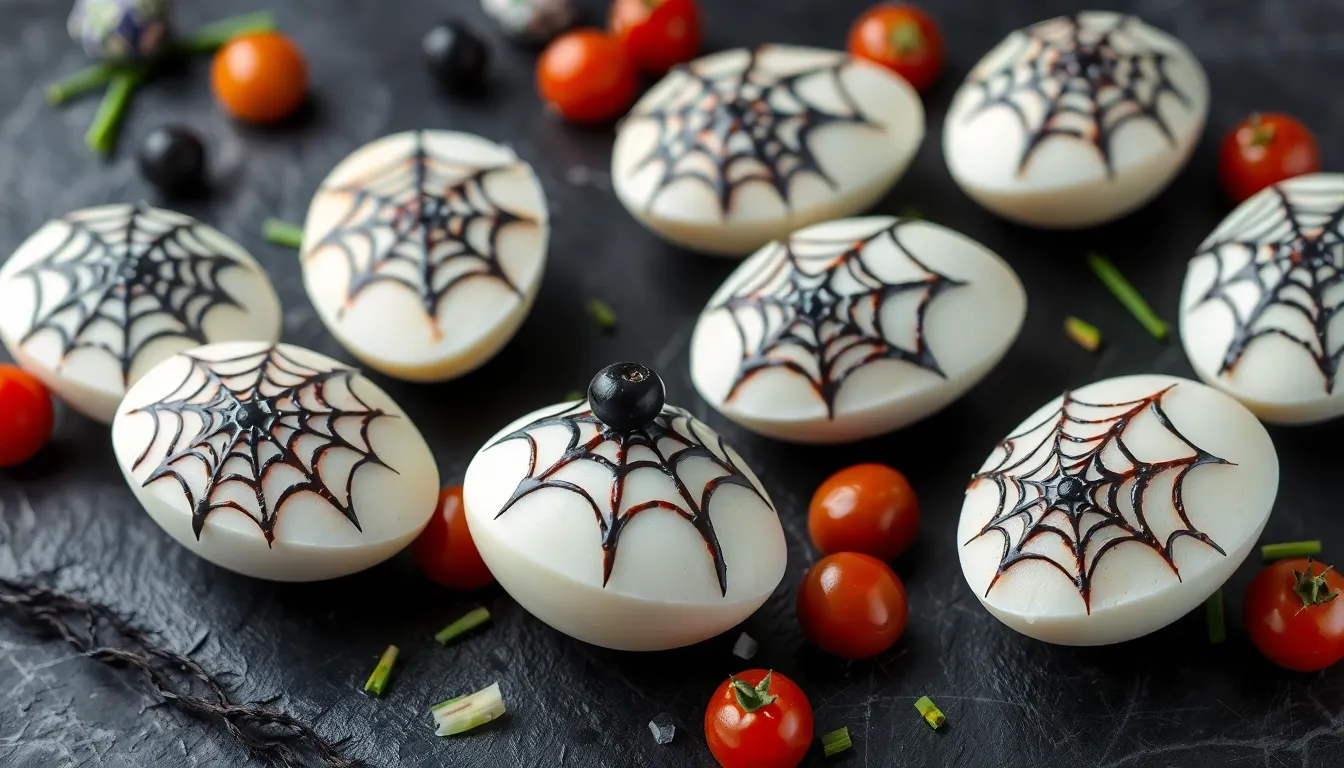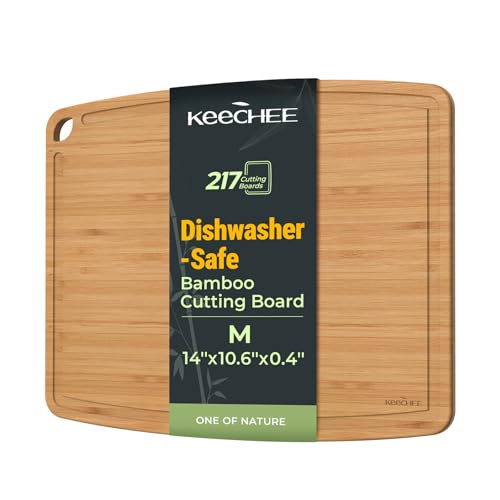Ingredients
These Halloween spiderweb eggs require simple pantry staples and fresh ingredients to create their dramatic appearance. Gather all components before starting to ensure smooth preparation.
For the Hard-Boiled Eggs
- 6 large eggs (room temperature for even cooking)
- Water (enough to cover eggs by 1 inch)
- 1 teaspoon salt (prevents cracking during boiling)
- Ice water bath (for immediate cooling)
For the Spiderweb Design
- 1/4 cup soy sauce (low sodium preferred)
- 2 black tea bags (or 2 teaspoons loose black tea)
- 1 cup hot water (for steeping tea)
- 1 tablespoon brown sugar (enhances color depth)
- 1/2 teaspoon Chinese five-spice powder (optional for extra flavor)
For the Spider Garnish
- 12 large black olives (pitted and halved for spider bodies)
- 1 bunch fresh chives (cut into thin strips for spider legs)
- 6 small cherry tomatoes (halved for serving base)
- Fresh parsley sprigs (for garnish and color contrast)
Equipment Needed
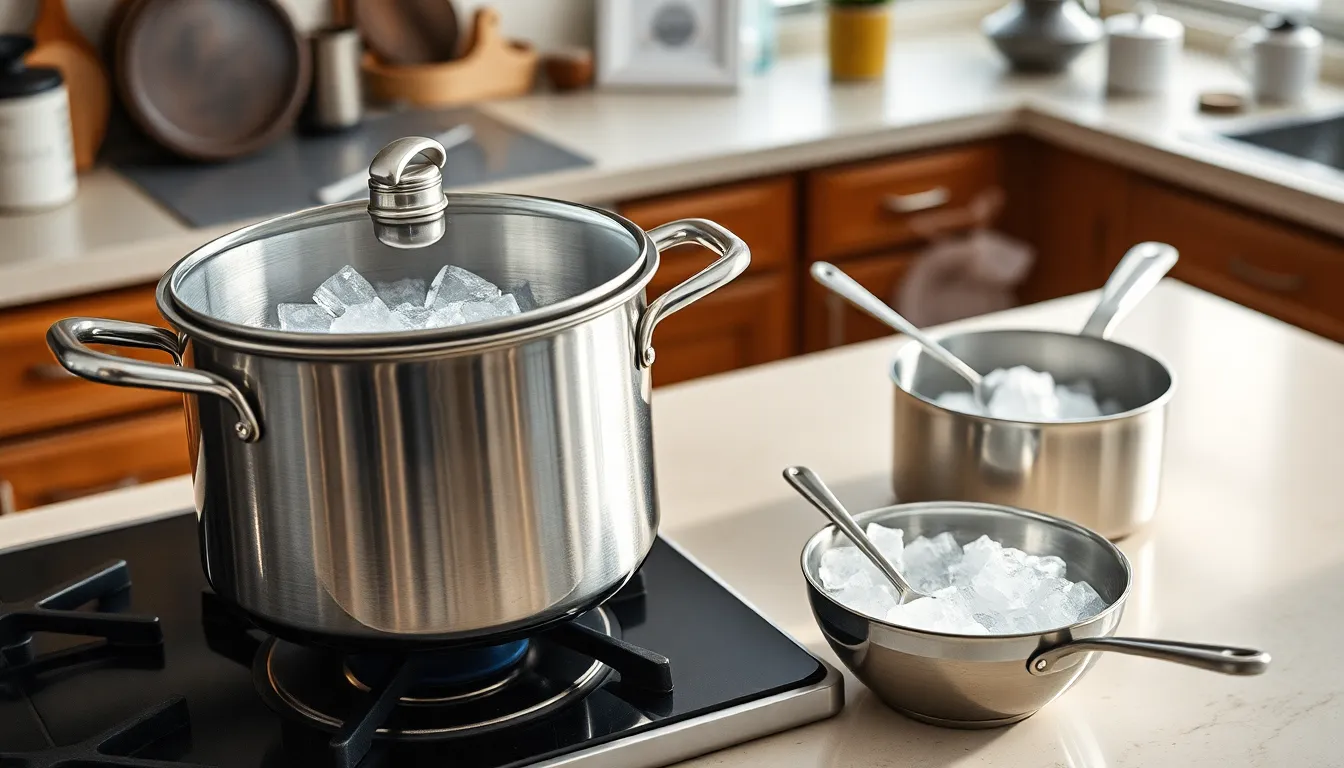
Your kitchen likely contains most tools necessary for creating these Halloween spiderweb eggs. A large saucepan forms the foundation for boiling eggs properly while maintaining consistent heat distribution. You’ll need a slotted spoon for safely transferring hot eggs without breaking the delicate shells.
Essential Cooking Equipment:
- Large saucepan with tight-fitting lid
- Medium mixing bowl for ice water bath
- Slotted spoon or spider strainer
- Small saucepan for tea mixture
- Fine-mesh strainer
- Sharp paring knife
A medium mixing bowl accommodates the ice water bath that stops the cooking process immediately. Your small saucepan handles the soy sauce and tea mixture preparation without overwhelming the stovetop space. Fine-mesh strainers remove tea leaves and spice particles for a smooth soaking liquid.
Preparation Tools:
- Cutting board
- Sharp paring knife for precise cuts
- Small spoons for ingredient measuring
- Clean kitchen towels
- Timer for accurate cooking intervals
Sharp paring knives create clean spider body cuts from black olives while maintaining their shape. Kitchen towels protect your workspace and provide gentle drying surfaces for the finished eggs. Digital or analog timers ensure perfect cooking times without guesswork.
Serving Essentials:
- Large serving platter
- Small bowls for garnish components
- Kitchen shears for herb trimming
Your serving platter showcases the spiderweb pattern effectively against a contrasting background. Small bowls organize garnish components like chopped chives and halved cherry tomatoes for efficient assembly. Kitchen shears trim fresh herbs cleanly without bruising delicate leaves.
Instructions
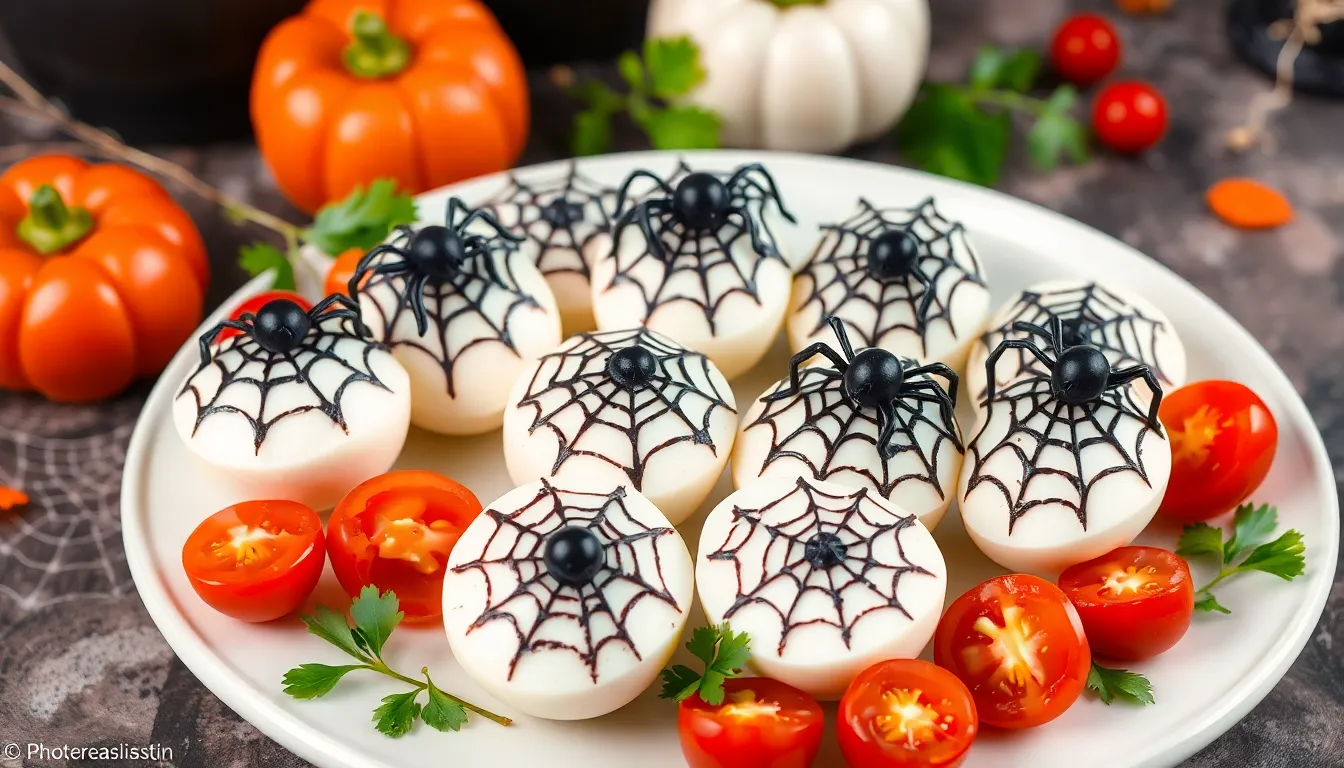
Transform ordinary hard-boiled eggs into spooky Halloween masterpieces with these detailed step-by-step instructions. Follow each stage carefully to achieve the perfect spiderweb pattern and creepy spider garnish.
Prep the Hard-Boiled Eggs
Place 6 large eggs in a large saucepan and cover with cold water by 1 inch. Add 1 teaspoon of salt to the water to prevent cracking. Bring the water to a rolling boil over high heat then immediately remove the pan from heat. Cover the saucepan and let the eggs sit for 12 minutes.
Prepare an ice water bath in a medium mixing bowl while the eggs cook. Fill the bowl with cold water and add plenty of ice cubes. Use a slotted spoon to transfer the hot eggs directly into the ice bath. Allow the eggs to cool completely for 5 minutes.
Gently tap each cooled egg all over with the back of a spoon to create small cracks in the shell. Keep the shell pieces attached to the egg white. The cracks should form an irregular web-like pattern across the entire surface. Avoid removing any shell pieces at this stage.
Create the Spiderweb Pattern
Combine 1/2 cup soy sauce with 2 tablespoons loose black tea in a small saucepan. Add 2 cups hot water and 1 tablespoon brown sugar to the mixture. Stir in 1/2 teaspoon Chinese five-spice powder if using. Bring the mixture to a boil over medium heat then reduce to a gentle simmer.
Carefully lower the cracked eggs into the simmering tea mixture using a slotted spoon. Ensure the liquid covers all eggs completely. Simmer the eggs for 15-20 minutes to allow the dark liquid to penetrate through the cracks. The longer you simmer the eggs the darker the web pattern will become.
Remove the eggs from the tea mixture and let them cool on a plate for 10 minutes. Gently peel away all shell pieces to reveal the intricate spiderweb pattern underneath. Rinse each egg under cold water to remove any loose tea particles. Pat the eggs dry with paper towels.
Make the Chocolate Spiders
Cut black olives in half lengthwise to create spider bodies. Each olive half will serve as one spider body. Slice the remaining olive pieces into thin strips for spider legs. Each spider needs 8 thin leg pieces.
Arrange 4 olive strips on each side of an olive half to create spider legs. Position the legs at slight angles to mimic natural spider positioning. Use small pieces of chives as additional leg accents if desired. Repeat this process to create 6 spiders total.
Assemble the Halloween Spiderweb Eggs
Arrange the spiderweb eggs on a large serving platter with the most dramatic web patterns facing up. Position each olive spider on top of an egg or nestled beside it on the platter. The dark spiders will create striking contrast against the marbled egg whites.
Garnish the platter with halved cherry tomatoes and fresh parsley sprigs around the edges. Place small bowls nearby containing extra olive spiders for guests who want additional toppings. Serve the spiderweb eggs immediately at room temperature or chilled from the refrigerator.
Serving Suggestions
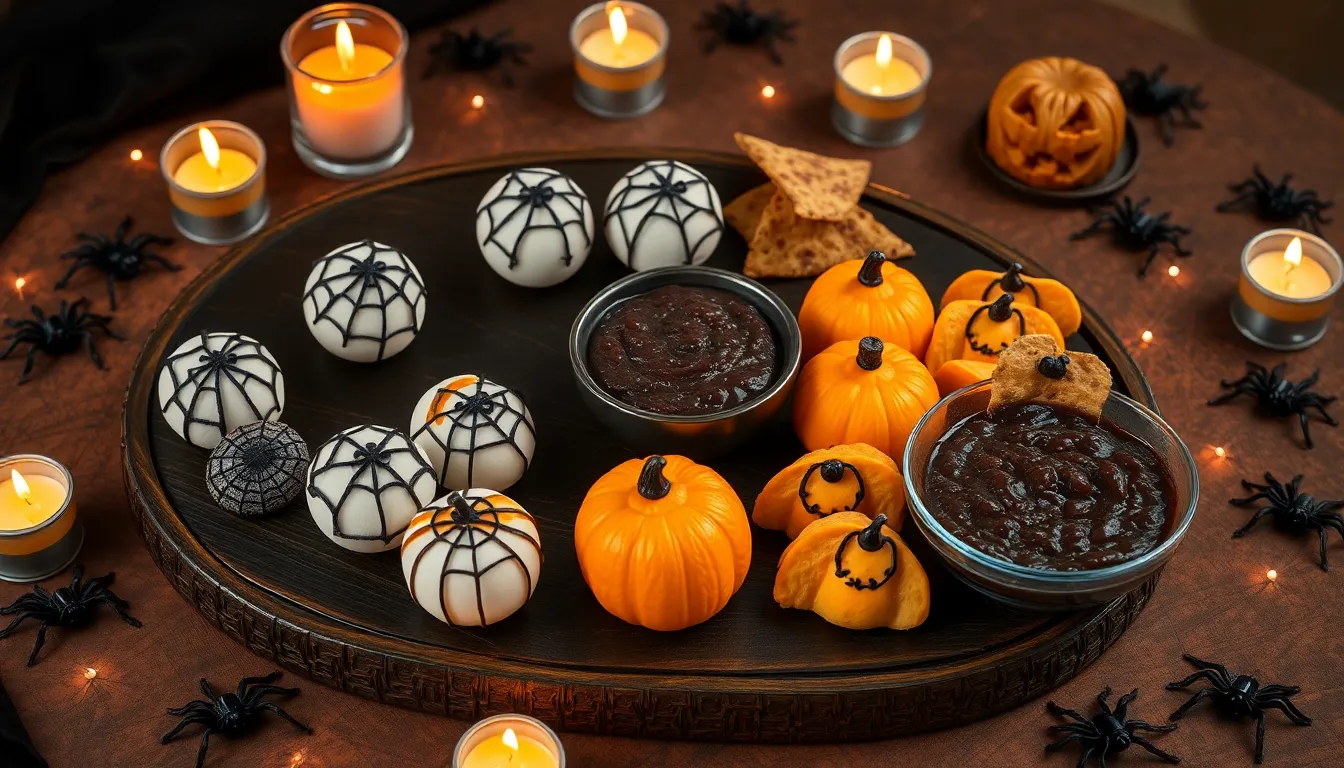
Transform your Halloween spiderweb eggs into the centerpiece of your spooky spread by arranging them on a black slate board or dark wooden platter. Position the eggs strategically around other Halloween appetizers like deviled eggs, cheese cubes, and crackers to create an eerie buffet display.
Pair these savory treats with complementary finger foods that enhance the Halloween theme. Serve alongside orange cheddar cheese cut into pumpkin shapes, black bean dip with tortilla chips, or mini sandwiches cut with bat-shaped cookie cutters. The salty flavor of the spiderweb eggs balances perfectly with sweet elements like candy corn or chocolate-covered pretzels.
Create an atmospheric presentation by dimming the lights and adding LED candles around your serving area. Scatter plastic spiders near the platter and drape artificial cobwebs over the edges of your serving table. Place dry ice in a nearby bowl for a foggy effect that makes your spiderweb eggs appear even more mysterious.
Consider serving these eggs as part of a themed brunch spread during Halloween weekend. Accompany them with pumpkin spice pancakes, orange juice served in mason jars, and coffee with cinnamon sticks. The protein-rich eggs provide a satisfying contrast to sweeter brunch items.
For adult Halloween parties, create a sophisticated presentation by serving the spiderweb eggs alongside a charcuterie board featuring dark breads, aged cheeses, and wine selections. The umami flavors from the soy sauce marinade complement bold red wines or create beers perfectly. Provide small appetizer plates and cocktail napkins for easy handling while guests mingle.
Temperature control ensures optimal enjoyment of your spiderweb eggs. Serve them at room temperature or slightly chilled for the best flavor profile. Remove them from refrigeration 15-20 minutes before serving to allow the flavors to fully develop and the eggs to reach the ideal texture.
Storage Instructions
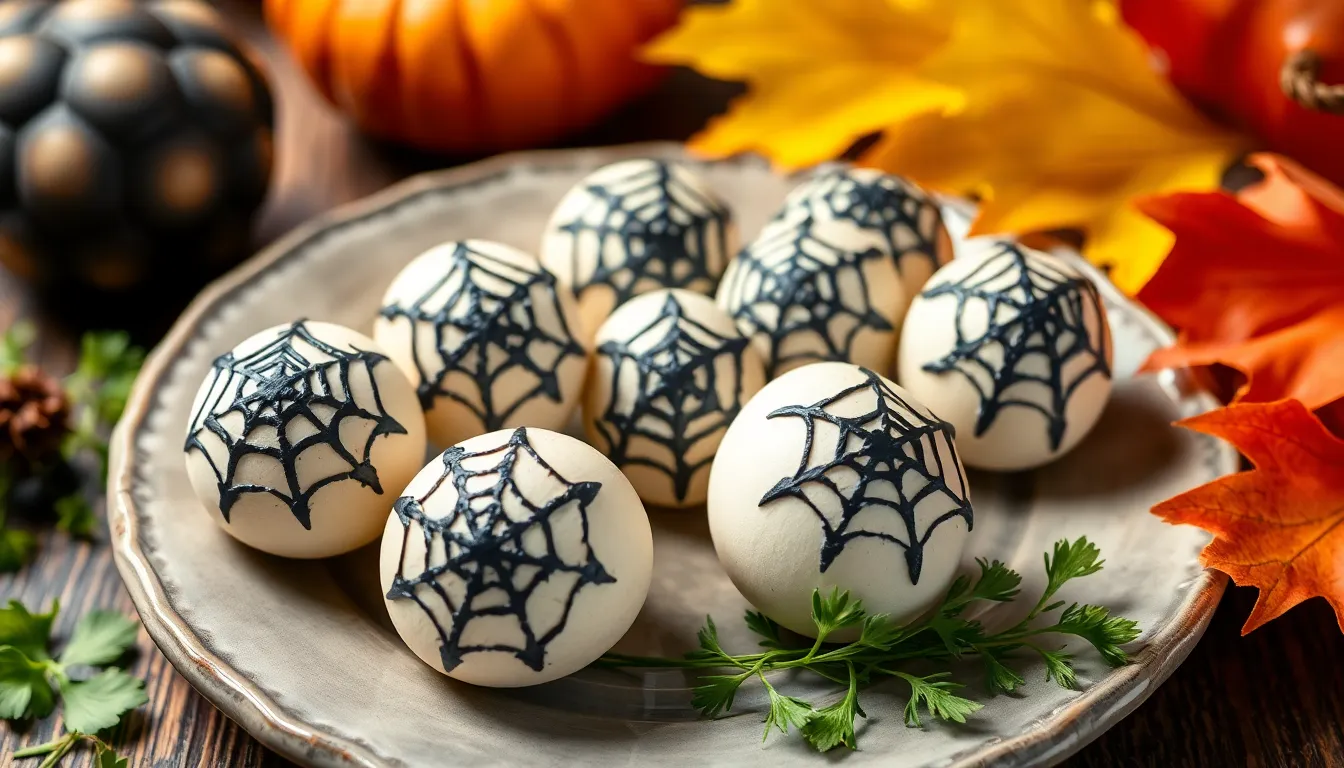
Store your Halloween spiderweb eggs in the refrigerator for optimal freshness and food safety. Place the decorated eggs in an airtight container lined with paper towels to absorb excess moisture from the soy sauce marinade. Your spiderweb eggs will maintain their striking appearance and flavor for up to 3 days when properly refrigerated.
Keep the eggs separate from strong-smelling foods to prevent flavor absorption. The soy sauce coating creates a natural protective barrier that helps preserve the eggs while maintaining their dramatic spiderweb pattern. Avoid storing the eggs at room temperature for more than 2 hours to prevent bacterial growth.
Remove the olive spider garnishes before storing if you plan to keep the eggs longer than 24 hours. Fresh herbs like chives and parsley should be stored separately and added just before serving to maintain their vibrant color and crisp texture. Store these garnishes in small containers with slightly damp paper towels to keep them fresh.
Wrap individual eggs in plastic wrap if you need to transport them to a party or event. This method prevents the spiderweb pattern from smudging while protecting the delicate tea-stained surface. Label your storage container with the preparation date to track freshness.
Bring refrigerated spiderweb eggs to room temperature 15 minutes before serving for the best flavor profile. The soy sauce marinade intensifies during storage, creating an even more pronounced savory taste that complements the Halloween presentation. Reassemble your spider garnishes and arrange fresh herbs just before your guests arrive for maximum visual impact.
Tips for Perfect Results

Start with room temperature eggs to prevent cracking during the boiling process. Cold eggs from the refrigerator can shock when placed in hot water and develop hairline fractures that affect the final spiderweb pattern.
Control your cracking technique for optimal web patterns. Gently tap the cooled eggs all over with the back of a spoon to create an even network of small cracks. Avoid hitting too hard as large cracks will create thick dark lines instead of delicate web patterns.
Monitor the tea mixture temperature carefully during the simmering process. Keep the soy sauce and tea solution at a gentle simmer rather than a rolling boil to ensure even penetration of the liquid into the egg cracks without overcooking the whites.
Time your soaking precisely for consistent results across all eggs. Fifteen to twenty minutes produces the ideal spiderweb darkness while maintaining the egg’s texture. Shorter soaking times create faint patterns while longer periods can make the eggs too salty.
Handle eggs gently when transferring between hot water and ice baths. Use a slotted spoon to avoid dropping eggs and creating additional unwanted cracks that disrupt the web pattern.
Prepare your ice bath thoroughly with plenty of ice cubes and cold water. The rapid temperature change helps set the web pattern and makes the eggs easier to peel without damaging the delicate design.
Test one egg first if you’re unsure about timing or technique. This allows you to adjust the soaking time or cracking method for the remaining eggs based on your initial results.
Keep garnish components cold until assembly time to maintain freshness. Prepare olive spiders and herb garnishes just before serving to ensure they look vibrant against the dark spiderweb pattern.
Pat eggs completely dry after removing them from the tea mixture. Excess moisture can dilute the web pattern and make garnishes slip off during presentation.
Variations and Customizations
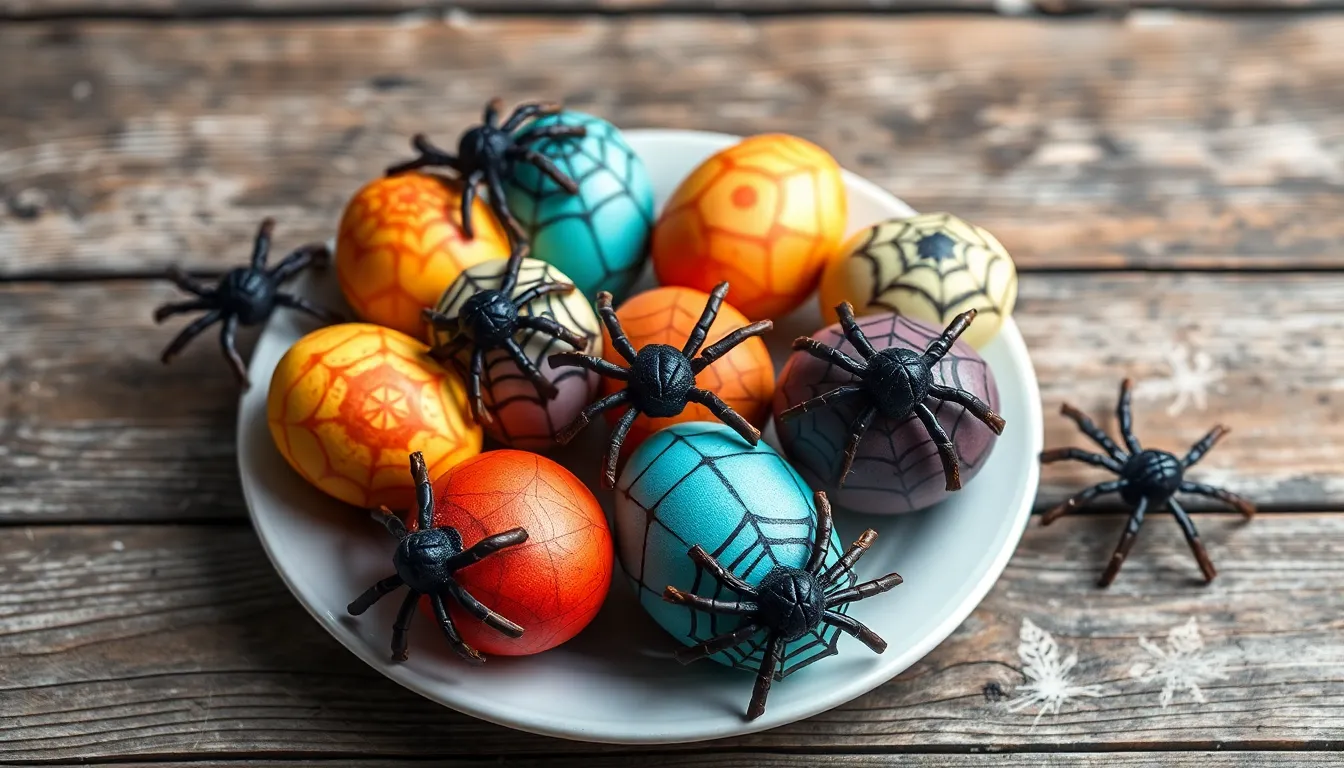
Transform your spiderweb eggs into unique creations by experimenting with different flavoring techniques and visual elements. You can substitute the black tea with Earl Grey for a citrusy undertone or use oolong tea for a more complex flavor profile. Green tea creates subtler web patterns while jasmine tea adds floral notes that complement the savory soy sauce base.
Adjust the spiderweb intensity by modifying your soaking time and soy sauce concentration. Darker webs emerge from longer soaking periods of 45-60 minutes while lighter patterns develop in just 20-30 minutes. You can create gradient effects by removing eggs at different intervals during the steeping process.
Color Variations
| Ingredient Addition | Color Result | Soaking Time |
|---|---|---|
| Beet juice | Deep purple webs | 30-40 minutes |
| Turmeric powder | Golden yellow patterns | 25-35 minutes |
| Red wine | Burgundy spider webs | 35-45 minutes |
| Pomegranate juice | Pink to red hues | 30-40 minutes |
Enhance the flavor profile by incorporating different spice blends into your tea mixture. Chinese five-spice powder adds warmth and complexity while star anise creates a licorice note. You can include cinnamon sticks for sweetness or bay leaves for an earthy undertone.
Spider Garnish Alternatives
Replace traditional black olive spiders with creative alternatives that match your theme preferences. Blackberries cut in half make excellent spider bodies with pretzel stick legs inserted around the edges. You can create spiders using black grapes paired with thin carrot strips or create them from dark chocolate chips with almond sliver legs.
Mini mozzarella balls work perfectly for white spider variations while cherry tomatoes provide red spider options. Slice mushrooms create realistic spider bodies when paired with chive stem legs cut to precise lengths.
Themed Adaptations
Customize your eggs for different occasions beyond Halloween celebrations. Easter variations use natural dyes like red cabbage for blue webs or onion skins for orange patterns. You can create Valentine’s Day versions using pomegranate juice for romantic pink webs topped with heart-shaped garnishes.
Summer party adaptations feature herb-infused tea mixtures using fresh thyme or rosemary for aromatic web patterns. Winter holiday versions incorporate mulling spices like cloves and allspice for festive flavoring that pairs well with seasonal gatherings.
Dietary Modifications
Adapt the recipe for various dietary needs by substituting ingredients without compromising the visual impact. Coconut aminos replace soy sauce for gluten-free versions while maintaining the dark coloring needed for web patterns. You can use tamari as another gluten-free alternative that provides similar umami depth.
Low-sodium variations work well with reduced-sodium soy sauce mixed with additional tea for color intensity. Vegan versions eliminate the eggs entirely but apply the same technique to firm tofu blocks cut into egg shapes for plant-based alternatives.
Conclusion
These Halloween spiderweb eggs prove that impressive party appetizers don’t require complicated techniques or expensive ingredients. You’ve got everything you need to create a show-stopping centerpiece that’ll have your guests talking long after the party ends.
The beauty of this recipe lies in its flexibility—you can adjust flavors experiment with different garnishes and even adapt the concept for other holidays. Whether you’re hosting a small gathering or a large Halloween bash these spiderweb eggs deliver maximum visual impact with minimal effort.
Your Halloween spread just got a major upgrade. Start preparing these haunting treats and watch as they become the star attraction at your next spooky celebration.

